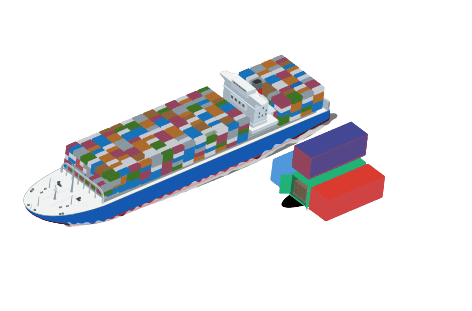The biggest challenge in dealing with maritime freight is keeping pre-negotiated costs, especially considering the current economic fluctuations. Or, in other words, how to obtain the best scenario amid so many fluctuations while maintaining space availability. In this article, we will address relevant points to enhance your understanding of this topic, as well as the prospects for maritime freight in the second half of 2023.
Economic Scenario for 2023
Economically, 2023 was expected to be the year when “the bill would come due.”
Inflation is like a debit note from a period when various global transportation conglomerates were able to thrive amid the crisis. This, surprisingly, came with increased transit times, reduced free times consequently – because container stocks didn’t turn fast enough – and even with limited options in some regions.
The scenario was one of hunger, combined with a desire to eat and rationed food, so to speak.
The fact is that the pandemic and lockdowns filled the pockets of many. On the other hand, in a national context, a return to normalcy brought new challenges. We’re talking about the war in Ukraine and the challenge of finding routes and suppliers that, besides replacing the Chinese, aren’t heading toward the conflict.
Even though the fluctuating economy has brought prosperity to many, inflation is, in general, a common concern for most countries with significant marketing power.
We can summarize the consequences of this scenario of rising prices caused by inflation. Among the challenges is undoubtedly a reduced purchasing power, which not only causes an indigestible increase in service contracting at prices that were not so high before but also directly impacts the reduction of negotiation margins and the postponement of deals that would have been sealed without further delay.
What Are the New Prospects for Maritime Freight in the Second Half of 2023?
Considering the stagnant market, given what we’ve discussed above, the prospects for maritime freight are one of stabilization, even with the peak season expected during this time.
The GRI (Global Reporting Initiative) continues to generate discomfort, leading to post-closure renegotiations. On the other hand, its advance somewhat provides a margin (albeit short) for analyzing options.
Remember that back in 2021, GRI was literally seasonal. However, today this seasonality has become a recurrence and comes to share the shipping company’s bill with the end customer.
With a lower volume, especially from the Asian market, and with the global market in general cooling down and first-world countries also discussing inflation and raising their interest rates, the market is “steadily oscillating,” but with prospects for maritime freight values much lower than those practiced during the pandemic.
We must also consider the ecological appeal we’re facing, which certainly adds costs that didn’t exist before. In other words, sustainability concerns regarding carbon emission reduction and compensation.
What Are the Impacts of Inflationary Pressure on My International Freight?
Considering the prospects for maritime freight, the fluctuation of the average ticket is a reality. Especially with new charges following ESG trends and a more environmentally concerned mindset. After all, 80% of international freight transportation is still maritime.
From an incremental point of view, it is correct to say that innovations in this sector make freight more expensive.
By way of example, we can mention new policies for IMO (dangerous or chemical) cargo and the passing on of decarbonization costs and new applications in bunker and fuel charges. In addition to more environmental fees, ship adaptation to compensate for pollutant emissions, and fleet recycling (scrapping of old ships).
Maritime Freight Quotes with Very Short Deadlines
Given the fluctuations and a higher rate of transfer and revisions, freight previously negotiated within a 15 to 30-day period no longer enjoys the same privilege. Not to mention that they are often considered SPOT, with the potential for adjustments in the shipping date or a validity of up to a maximum of 15 days, with prospects for maritime freight to maintain price/space.
Freight Forwarders Struggling with BID Negotiations
Long-term negotiations, known as BID, have been a challenge. This is because competition is fierce, and margins are slim, which should be seen as an opportunity for innovation and creativity on many fronts.
Source: https://www.freepik.com/free-photo/medium-shot-man-working-outdoors_13291133.htm
In general, large volumes have been avoided due to monitoring fluctuations. In other words, those who close BID don’t want it, don’t like it, and seek to avoid the common market fluctuations.
And much of this is due to the protection of the commodity price. After all, freight is considered an embedded cost, and fluctuations can significantly reduce the profit margin of the final product.
Grow Amid Global Market Changes with Cheap2ship
Given the increasing demands and fluctuations, Excel compilations and email accumulations, as well as constant updates, it is practically impossible to manually keep all the necessary information on hand to quote and obtain a competitive price close to reality.
With the variety of players and solutions in the market, the Cheap2Ship platform not only aggregates content but also delivers speed and accuracy and saves not only time in quoting and decision-making but also provides a closer notion of what the market is practicing. And all this in real time.
Our platform also allows for time analysis, with route analysis and viability at the time of quoting, as it provides a complete view of everything that is needed on the screen, making it easier to see what can be more or less profitable.
This results not only in precise and agile negotiations, with constantly updated information, considering the various ports and destinations on time. Furthermore, it mitigates losses caused by counterproposals that pressure agents to further reduce their rates based on competition offers – often unrealistic.
It’s the efficient panorama: price, variation, routes, and frequency. All of this available, in clicks, to revolutionize the way you present, analyze, and quote your freight.

